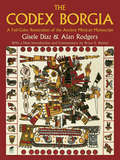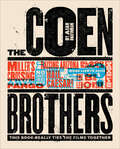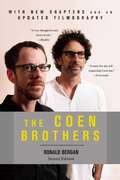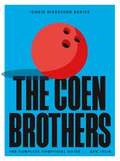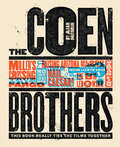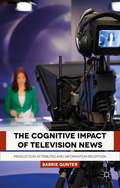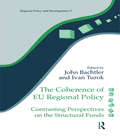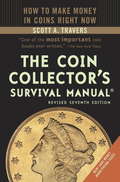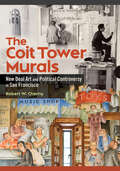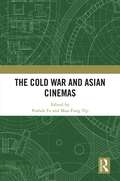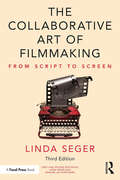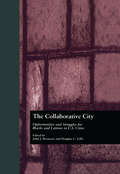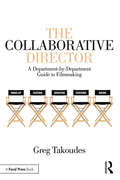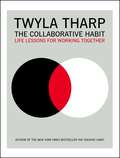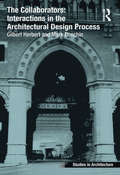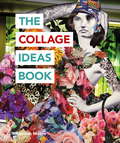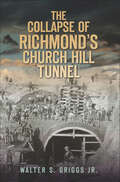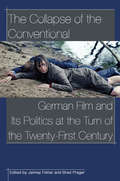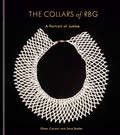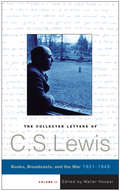- Table View
- List View
The Codex Borgia: A Full-Color Restoration of the Ancient Mexican Manuscript
by Alan Rodgers Gisele DíazConsidered by many scholars the finest extant Mexican codex and one of the most important original sources for the study of pre-Columbian religion, the Codex Borgia is a work of profound beauty, filled with strange and evocative images related to calendrical, cosmological, ritual, and divinatory matters. Generally similar to such Mixtec manuscripts as the Codex Nuttall, the Codex Borgia is thought to have its origin (ca. A.D. 1400) in the southern central highlands of Mexico, perhaps in Puebla or Oaxaca. It is most probably a religious document that once belonged to a temple or sacred shrine.One use of the Codex many have been to divine the future, for it includes ritual 260 day calendars, material on aspects of the planet Venus, and a sort of numerological prognostic of the lives of wedded couples. Another section concerns various regions of the world and the supernatural characters and attributes of those regions. Also described are the characteristics of a number of deities, while still other passages relate to installation ceremonies of rulers in pre-Columbian kingdoms.Until the publication of this Dover edition, the Codex Borgia has been largely inaccessible to the general public. The priceless original is in the Vatican Library and previous photographic facsimiles are very rare or very expensive or both. Moreover, the original Codex has been damaged over the centuries, resulting in the obscuration and loss of many images. In order to recapture the beauty and grandeur of the original, Gisele Diaz and Alan Rodgers have painstakingly restored the Codex by hand-- a seven-year project -- employing the most scrupulous research and restoration techniques. The result is 76 large full-color plates of vibrant, striking depictions of gods, kings, warriors, mythical creatures, and mysterious abstract designs -- a vivid panorama that offers profound insights into pre-Columbian Mexican myth and ritual. Now students, anthropologists, lovers of fine art and rare books -- anyone interested in the art and culture of ancient Mexico -- can study the Codex Borgia in this inexpensive, accurate, well-made edition. An informative introduction by noted anthropologist Bruce E. Byland places the Codex in its historical context and helps elucidate its meaning and significance.
The Codex Nuttall
by Zelia NuttallThe only value-priced, full-color edition of the pre-Columbian Mexican (Mixtec) book. Features 88 color plates of kings, gods, heroes, temples, sacrifices, and more. New introduction.
The Coen Brothers (Text-only Edition): This Book Really Ties the Films Together
by Adam NaymanFans of Fargo, The Big Lebowski, No Country for Old Men, and other modern classics will enjoy this “definitive history of the Coen brothers oeuvre” (Indiewire).From such cult hits as Raising Arizona (1987) and The Big Lebowski (1998) to major critical darlings Fargo (1996), No Country for Old Men (2007), and Inside Llewyn Davis (2013), Ethan and Joel Coen have cultivated a bleakly comical, instantly recognizable voice in modern American cinema. In The Coen Brothers: This Book Really Ties the Films Together, film critic Adam Nayman carefully sifts through their complex cinematic universe in an effort to plot, as he puts it, “some Grand Unified Theory of Coen-ness.” With a combination of biography, close analysis, and enlightening interviews with key Coen collaborators, this book honors the films’ singular mix of darkness and levity, and is the definitive exploration of the Coen brothers’ oeuvre.
The Coen Brothers Second Edition
by Ronald BerganBrought completely up to date, this insightful biography remains "a must for any self-respecting Coen fan" (Screentrade). This fully updated edition of the first biography of the Coen Brothers includes their complete work so far, from Blood Simple to Inside Llewyn Davis (2013), with a reassessment of their remarkable career as a whole. Joel and Ethan Coen have pulled off the ultimate balancing act. Despite having their movies financed and distributed by major studios, they have managed to remain true independents, rejecting commercial clichés and never giving up on their own fiercely idiosyncratic vision. While doing so, they have established themselves among the world's leading filmmakers. From their startling debut, Blood Simple (1984), all of their movies reveal a distinctive stamp: a flamboyant visual style, richly conceived characters, crisp dialogue, and brilliant casting. They have revitalized old Hollywood genres such as noir, screwball, and the western, giving them a contemporary sensibility. In this biography, Ronald Bergan traces the brothers' Jewish roots, their beginnings as film geeks in suburban Minneapolis, their battle to get their first feature made and released, through their early features and the movies of their maturity. He gives blow-by-blow accounts of the making of each movie. New chapters cover all those released since O Brother, Where Art Thou? (2000), with which the first edition of this book ended.
The Coen Brothers: The Complete Unofficial Guide (Iconic Directors)
by Dan JolinGangster movie, Western, film noir, rom com, screwball, musical, even the Biblical epic... There are few genres left untouched and untwisted by sibling visionaries Joel and Ethan Coen. Since 1984's Blood Simple, the inscrutable brothers have effortlessly forged their own cinematic path, avoiding prevailing trends while crafting bold, stylish and witty movies that feel fresh and distinctive despite being deeply rooted in their creators' filmic passion and knowledge.This is a definitive guide to that path, bringing the reader through Joel and Ethan's 20 features (not counting the mezzanine) and exploring thethemes, the tropes, the gags, the familiar faces - while also taking in all the Coen curios that litter this quirkily winding byway.From Texas to Minnesota, from Homer to Shakespeare, from Bluegrass to Busby Berkeley, from wrestling to bowling, from lost hats to severed toes, this book covers everything that one might reasonably consider (to use a word that would likely make Joel and Ethan wince) 'Coenesque'... And then some.
The Coen Brothers: The Complete Unofficial Guide (Iconic Directors)
by Dan JolinGangster movie, Western, film noir, rom com, screwball, musical, even the Biblical epic... There are few genres left untouched and untwisted by sibling visionaries Joel and Ethan Coen. Since 1984's Blood Simple, the inscrutable brothers have effortlessly forged their own cinematic path, avoiding prevailing trends while crafting bold, stylish and witty movies that feel fresh and distinctive despite being deeply rooted in their creators' filmic passion and knowledge.This is a definitive guide to that path, bringing the reader through Joel and Ethan's 20 features (not counting the mezzanine) and exploring thethemes, the tropes, the gags, the familiar faces - while also taking in all the Coen curios that litter this quirkily winding byway.From Texas to Minnesota, from Homer to Shakespeare, from Bluegrass to Busby Berkeley, from wrestling to bowling, from lost hats to severed toes, this book covers everything that one might reasonably consider (to use a word that would likely make Joel and Ethan wince) 'Coenesque'... And then some.
The Coen Brothers: This Book Really Ties the Films Together
by Adam Nayman“Color stills, behind-the-scenes stories, interviews and insightful analysis of each film…will put a smile on the face of all film buffs.” ?The Detroit Free PressFrom such cult hits as Raising Arizona (1987) and The Big Lebowski (1998) to major critical darlings Fargo (1996), No Country for Old Men (2007), and Inside Llewyn Davis (2013), Ethan and Joel Coen have cultivated a bleakly comical, instantly recognizable voice in modern American cinema. In The Coen Brothers: This Book Really Ties the Films Together, film critic Adam Nayman carefully sifts through their complex cinematic universe in an effort to plot, as he puts it, “some Grand Unified Theory of Coen-ness.” The book combines critical text—biography, close film analysis, and enlightening interviews with key Coen collaborators—with a visual aesthetic that honors the Coens’ singular mix of darkness and levity. Featuring film stills, beautiful and evocative illustrations, punchy infographics, and hard insight, this book is the definitive exploration of the Coen brothers’ oeuvre.
The Cognitive Impact of Television News
by Barrie GunterResearch shows that, while people around the world consistently nominate television as their most important news source, much of the content of news bulletins is lost to viewers within moments. In response, Barrie Gunter argues that this can be explained by the way in which televised news is written, packaged and presented.
The Coherence of EU Regional Policy: Contrasting Perspectives on the Structural Funds (Regions and Cities #Vol. 16)
by Ivan Turok John BachtlerThis book brings together a rich selection of up-to-date practical experience of EU regional policy from across Europe. It provides different perspectives on the design and operation of regional development strategies under the Structural Funds, from people closely involved in studying, managing or advising on the process at EU, national and regional levels. It therefore offers a more comprehensive and detailed understanding of the structural policies than has been available hitherto. This will prove particularly useful to researchers, practitioners and students interested in European regional policies and processes.
The Coin Collector's Survival Manual, Revised Seventh Edition
by Scott A. TraversRevised and Updated for the Gold Rush From one of the world's most knowledgeable coin dealers-a former consultant to the Federal Trade Commission who is often quoted by the Wall Street Journal-comes a thorough update of the most-trusted consumer protection handbook to buying and selling rare and valuable coins. Illustrated with black-and-white photographs and a full-color insert, The Coin Collector's Survival Manual, Seventh Edition is indispensable for seasoned collectors and novices alike. This substantially revised edition of the Coin Collector's Survival Manual includes revised chapters that focus on legal and financial advice for buying and selling coins, and a new chapter on the most secure way to detect coins that have been "doctored." You will learn how to: * Avoid scams when buying and selling gold* Understand the new coin grading system* Detect altered, counterfeit, and doctored coins * Know how high gold and silver coins will climb in value* Buy coins through Internet auctions-and avoid the pitfalls* Safeguard and protect your coins from disaster ABOUT THE AUTHOR:Scott Travers, former vice president of the American Numismatic Association, was called the "preeminent consumer advocate in the numismatic field" by The New York Times. He is a contributor to all the leading coin publications and served as a coin valuation consultant to the Federal Trade Commission. He has been featured as a coin expert in Barron's, Business Week, The WSJ, MSNBC and TODAY.
The Coit Tower Murals: New Deal Art and Political Controversy in San Francisco
by Robert W. ChernyCreated in 1934, the Coit Tower murals were sponsored by the Public Works of Art Project (PWAP), the first of the New Deal art programs. Twenty-five master artists and their assistants worked there, most of them in buon fresco, Nearly all of them drew upon the palette and style of Diego Rivera. The project boosted the careers of Victor Arnautoff, Lucien Labaudt, Bernard Zakheim, and others, but Communist symbols in a few murals sparked the first of many national controversies over New Deal art. Sixty full-color photographs illustrate Robert Cherny’s history of the murals from their conception and completion through their evolution into a beloved San Francisco landmark. Cherny traces and critiques the treatment of the murals by art critics and historians. He also probes the legacies of Coit Tower and the PWAP before surveying San Francisco’s recent controversies over New Deal murals. An engaging account of an artistic landmark, The Coit Tower Murals tells the full story behind a public art masterpiece.
The Cold War and Asian Cinemas
by Man-Fung Yip Poshek FuThis book offers an interdisciplinary, historically grounded study of Asian cinemas’ complex responses to the Cold War conflict. It situates the global ideological rivalry within regional and local political, social, and cultural processes, while offering a transnational and cross-regional focus. This volume makes a major contribution to constructing a cultural and popular cinema history of the global Cold War. Its geographical focus is set on East Asia, Southeast Asia, and South Asia. In adopting such an inclusive approach, it draws attention to the different manifestations and meanings of the connections between the Cold War and cinema across Asian borders. Many essays in the volume have a transnational and cross-regional focus, one that sheds light on Cold War-influenced networks (such as the circulation of socialist films across communist countries) and on the efforts of American agencies (such as the United States Information Service and the Asia Foundation) to establish a transregional infrastructure of "free cinema" to contain the communist influences in Asia. With its interdisciplinary orientation and broad geographical focus, the book will appeal to scholars and students from a wide variety of fields, including film studies, history (especially the burgeoning field of cultural Cold War studies), Asian studies, and US-Asian cultural relations.
The Collaboration
by Ben UrwandTo continue doing business in Germany after Hitler's ascent to power, Hollywood studios agreed not to make films that attacked the Nazis or condemned Germany's persecution of Jews. Ben Urwand reveals this bargain for the first time--a "collaboration" (Zusammenarbeit) that drew in a cast of characters ranging from notorious German political leaders such as Goebbels to Hollywood icons such as Louis B. Mayer. At the center of Urwand's story is Hitler himself, who was obsessed with movies and recognized their power to shape public opinion. In December 1930, his Party rioted against the Berlin screening of All Quiet on the Western Front, which led to a chain of unfortunate events and decisions. Fearful of losing access to the German market, all of the Hollywood studios started making concessions to the German government, and when Hitler came to power in January 1933, the studios--many of which were headed by Jews--began dealing with his representatives directly. Urwand shows that the arrangement remained in place through the 1930s, as Hollywood studios met regularly with the German consul in Los Angeles and changed or canceled movies according to his wishes. Paramount and Fox invested profits made from the German market in German newsreels, while MGM financed the production of German armaments. Painstakingly marshaling previously unexamined archival evidence, The Collaboration raises the curtain on a hidden episode in Hollywood--and American--history.
The Collaborative Art of Filmmaking: From Script to Screen
by Linda SegerThe Collaborative Art of Filmmaking: From Script to Screen explores what goes into the making of Hollywood’s greatest motion pictures. Join veteran script consultant Linda Seger as she examines contemporary and classic screenplays on their perilous journey from script to screen. This fully revised and updated edition includes interviews with over 80 well-known artists in their fields including writers, producers, directors, actors, editors, composers, and production designers. Their discussions about the art and craft of filmmaking – including how and why they make their decisions – provides filmmaking and screenwriting students and professionals with the ultimate guide to creating the best possible "blueprint" for a film and to also fully understand the artistic and technical decisions being made by all those involved in the process.
The Collaborative City: Opportunities and Struggles for Blacks and Latinos in U.S. Cities (Contemporary Urban Affairs)
by John Betancur Douglas GillsFirst published in 2000. Routledge is an imprint of Taylor & Francis, an informa company.
The Collaborative Director: A Department-by-Department Guide to Filmmaking
by Greg TakoudesThe Collaborative Director: A Department-by-Department Guide to Filmmaking explores the directorial process in a way that allows the director to gather the best ideas from the departments that make up a film crew, while making sure that it is the director’s vision being shown on screen. It goes beyond the core concepts of vision, aesthetic taste, and storytelling to teach how to effectively collaborate with each team and fully tap into their creative potential. The structure of the book follows a budget top sheet, with each chapter describing the workflow and responsibilities of a different department and giving insights into the methods and techniques a director can use to understand the roles and dynamics. Each chapter is divided into four sections. Section one provides an overview of the department, section two focuses on directors who have used that department in notably effective ways, section three looks at collaboration from the reverse perspective with interviews from department members, and section four concludes each chapter with a set of tasks directors can use to prepare. Ideal for beginner and intermediate filmmaking students, as well as aspiring filmmakers and early career professionals, this book provides invaluable insight into the different departments, and how a director can utilize the skills and experience of a crew to lead with knowledge and confidence.
The Collaborative Habit: Life Lessons for Working Together
by Jesse Kornbluth Twyla TharpIn a career that has spanned four decades, choreographer Twyla Tharp has collaborated with great musicians, designers, thousands of dancers, and almost a hundred companies. She's experienced the thrill of shared achievement and has seen what happens when group efforts fizzle. Her professional life has been -- and continues to be -- one collaboration after another. In this practical sequel to her national bestseller The Creative Habit, Tharp explains why collaboration is important to her -- and can be for you. She shows how to recognize good candidates for partnership and how to build one successfully, and analyzes dysfunctional collaborations. And although this isn't a book that promises to help you deepen your romantic life, she suggests that the lessons you learn by working together professionally can help you in your personal relationships. These lessons about planning, listening, organizing, troubleshooting, and using your talents and those of your coworkers to the fullest are not limited to the arts; they are the building blocks of working with others, like if you're stuck in a 9-to-5 job and have an unhelpful boss. Tharp sees collaboration as a daily practice, and her book is rich in examples from her career. Starting as a twelve-year-old teaching dance to her brothers in a small town in California and moving through her work as a fledgling choreographer in New York, she learns lessons that have enriched her collaborations with Billy Joel, Jerome Robbins, Mikhail Baryshnikov, Bob Dylan, Elvis Costello, David Byrne, Richard Avedon, Milos Forman, Norma Kamali, and Frank Sinatra. Among the surprising and inspiring points Tharp makes in The Collaborative Habit: -Nothing forces change more dramatically than a new partnership. -In a good collaboration, differences between partners mean that one plus one will always equal more than two. A good collaborator is easier to find than a good friend. If you've got a true friendship, you want to protect that. To work together is to risk it. -Everyone who uses e-mail is a virtual collaborator. -Getting involved with your collaborator's problems may distract you from your own, but it usually leads to disaster. -When you have history, you have ghosts. If you're returning to an old collaboration, begin at the beginning. No evocation of old problems and old solutions. -Tharp's conclusion: What we can learn about working creatively and in harmony can transform our lives, and our world.
The Collaborators: Interactions In The Architectural Design Process (Ashgate Studies in Architecture)
by Gilbert Herbert Mark DonchinIllustrated by critical analyses of significant buildings, including examples by such eminent architects as Adler and Sullivan, Erich Mendelsohn, and Louis Kahn, this book examines collaboration in the architectural design process over a period ranging from the mid-19th century to the late 1960s. The examples chosen, located in England, the United States, Israel and South Africa, are of international scope. They have intrinsic interest as works of architecture, and illustrate all facets of collaboration, involving architects, engineers and clients. Prior to dealing with the case studies the theoretical framework is set in three introductory essays which discuss in general terms the organizational implications of partnerships, associations and teams; the nature of interactions between architect and engineer; and cooperation and confrontation in the relationship between architect and client. From this original standpoint, the interactive role of the designers, it examines and reinterprets such well-known buildings as the Chicago Auditorium and the Kimbell Art Museum. The re-evaluation of St Pancras Station and its hotel questions common presumptions about the separation of professional roles played by its engineer and architect. The account of the troubled history of Mendelsohn’s project for the first Haifa Power House highlights the difficulties that arise when a determined and eminent architect confronts a powerful and demanding client. In a later era, the examination of the John Moffat Building, which is less well known but deserving of wider recognition, reveals how the fruitful collaboration of multiple architects can result in a successful unified design. These case studies comprise a wide range of programmes, challenges, personalities and interactions. Ultimately, in five different ways, in five different epochs, and in five different circumstantial and cultural contexts, this book shows how the dialogue between the players in the design process resonates upo
The Collage Ideas Book (The Art Ideas Books)
by Alannah MooreCollage allows your creativity to run riot. It lets you juxtapose disparate elements, styles, and media against each other and create something entirely novel, bizarre, arresting, beautiful, ironic, or unsettling. Old and new can be fused together; the digital and hand-made can be combined.What you can create with collage knows no bounds.This little book is full of big ideas from contemporary collage artists to inspire you to think differently. It's the perfect gift for creative friends and family, providing inspiration for curious beginners as well as seasoned collagists looking for new ways of working. With a new idea on every page, you will discover fresh ways of tackling the medium to create work that is original and exciting.Ideas include:- monoprint- embroidery- felting- portraiture- painting- body art- sketchbooking- miniature dioramas- Surrealism- Photoshop- and many more!
The Collapse of Richmond's Church Hill Tunnel (Disaster)
by Walter S. Griggs Jr.Explore the facts and mysteries surrounding the history and collapse of Richmond, Virginia's Church Hill Tunnel. A must for fans of railroad and Richmond history.Richmond, the capital of the Confederacy, was in shambles after the Civil War. The bulk of Reconstruction became dependent on the railways, and one of the most important links in the system was the Church Hill Tunnel. The tunnel was eventually rendered obsolete by an alternative path over a viaduct, and it was closed for regular operation in 1902. However, the city still used it infrequently to transport supplies, and it was maintained with regular safety inspections. The city decided to reopen the tunnel in 1925 due to overcrowding on the viaduct, but the tunnel needed to be strengthened and enlarged. On October 2, 1925, 190 ft. of the tunnel unexpectedly caved in, trapping construction workers and an entire locomotive inside.In recent years, there has been a renewed interest in the tunnel and the mystery surrounding its collapse. There were cave-ins and sink holes above the surface for decades after the tunnel was sealed up, and in 1998, a reporter from the Richmond Times-Dispatch did an investigation, trying to determine the current condition of the tunnel. In 2006, the Virginia Historical Society announced its efforts to try and excavate the locomotive and remaining bodies.
The Collapse of the Conventional: German Film and Its Politics at the Turn of the Twenty-First Century
by Brad Prager Jaimey FisherAnalyzes a diverse body of films and investigates the renaissance that has taken place in German cinema since the turn of the twenty-first century.
The Collars of RBG: A Portrait of Justice
by Sara Bader Elinor CarucciA striking portrait of Justice Ruth Bader Ginsburg and her historic tenure on the United States Supreme Court, brought to life with incisive quotes and bold photographs of her iconic collars.&“RBG was unlike any other. So is this visual tribute to her.&”—Pete Souza, #1 New York Times bestselling author of Obama: An Intimate PortraitThe collar is a powerful point of entry for exploring Justice Ruth Bader Ginsburg's life and her tireless work on America&’s highest court. The twenty-five neckpieces captured here—in over eighty stunning photographs by award-winning photographer Elinor Carucci—offer insight into RBG&’s legacy. Her sharp use of language, a linchpin of her notorious dissents, is celebrated throughout, with quotes to support each collar and its story. The bold, ornate, and subversive collars she chose to wear on the bench communicated so much more. Shortly after RBG&’s passing in September, 2020, Carucci was commissioned by Time magazine for a commemorative piece on the late justice, focused on the stories behind her legendary collars. Here, Carucci and co-author Sara Bader use each collar to highlight a defining career moment, from RBG's earliest argument for gender equality to her support of immigration and marriage equality during her twenty-fifth year on the bench. Some of her collars are well-known, like her dissent collar, or her favorite white beaded neckpiece that she wore for important portraits. Other collars are less familiar but tell poignant stories of artists, colleagues, friends, and fans whose gifts to Justice Ginsburg found meaning in her hands.Small in stature but towering in influence, Justice Ruth Bader Ginsburg was described as a titan, a civil rights hero, and most poetically, by her colleague Justice Stephen Breyer, &“a rock of righteousness.&” The Collars of RBG is an artful collection of moments from this warrior&’s legacy, crystallizing the many ways RBG reshaped the cultural landscape for us all.
The Collected Letters of C.S. Lewis, Volume 2
by C. S. LewisC. S. Lewis was a prolific letter writer, and his personal correspondence reveals much of his private life, reflections, friendships, and the progress of his thought. This second of a three-volume collection contains the letters Lewis wrote after his conversion to Christianity, as he began a lifetime of serious writing. Lewis corresponded with many of the twentieth century's major literary figures, including J. R. R. Tolkien and Dorothy Sayers. Here we encounter a surge of letters in response to a new audience of laypeople who wrote to him after the great success of his BBC radio broadcasts during World War II -- talks that would ultimately become his masterwork, Mere Christianity. Volume II begins with C. S. Lewis writing his first major work of literary history, The Allegory of Love, which established him as a scholar with imaginative power. These letters trace his creative journey and recount his new circle of friends, "The Inklings," who meet regularly to share their writing. Tolkien reads aloud chapters of his unfinished The Lord of the Rings, while Lewis shares portions of his first novel, Out of the Silent Planet. Lewis's weekly letters to his brother, Warnie, away serving in the army during World War II, lead him to begin writing his first spiritual work, The Problem of Pain. After the serialization of The Screwtape Letters, the director of religious broadcasting at the BBC approached Lewis and the "Mere Christianity" talks were born. With his new broadcasting career, Lewis was inundated with letters from all over the world. His faithful, thoughtful responses to numerous questions reveal the clarity and wisdom of his theological and intellectual beliefs. Volume II includes Lewis's correspondence with great writers such as Owen Barfield, Arthur C. Clarke, Sheldon Vanauken, and Dom Bede Griffiths. The letters address many of Lewis's interests -- theology, literary criticism, poetry, fantasy, and children's stories -- as well as reveal his relation ships with close friends and family. But what is apparent throughout this volume is how this quiet bachelor professor in England touched the lives of many through an amazing discipline of personal correspondence. Walter Hooper's insightful notes and compre hensive biographical appendix of the correspon dents make this an irreplaceable reference for those curious about the life and work of one of the most creative minds of the modern era.
The Collected Letters of C.S. Lewis, Volume 2
by C. S. LewisC. S. Lewis was a prolific letter writer, and his personal correspondence reveals much of his private life, reflections, friendships, and the progress of his thought. This second of a three-volume collection contains the letters Lewis wrote after his conversion to Christianity, as he began a lifetime of serious writing. Lewis corresponded with many of the twentieth century's major literary figures, including J. R. R. Tolkien and Dorothy Sayers. Here we encounter a surge of letters in response to a new audience of laypeople who wrote to him after the great success of his BBC radio broadcasts during World War II -- talks that would ultimately become his masterwork, Mere Christianity.Volume II begins with C. S. Lewis writing his first major work of literary history, The Allegory of Love, which established him as a scholar with imaginative power. These letters trace his creative journey and recount his new circle of friends, "The Inklings," who meet regularly to share their writing. Tolkien reads aloud chapters of his unfinished The Lord of the Rings, while Lewis shares portions of his first novel, Out of the Silent Planet. Lewis's weekly letters to his brother, Warnie, away serving in the army during World War II, lead him to begin writing his first spiritual work, The Problem of Pain.After the serialization of The Screwtape Letters, the director of religious broadcasting at the BBC approached Lewis and the "Mere Christianity" talks were born. With his new broadcasting career, Lewis was inundated with letters from all over the world. His faithful, thoughtful responses to numerous questions reveal the clarity and wisdom of his theological and intellectual beliefs.Volume II includes Lewis's correspondence with great writers such as Owen Barfield, Arthur C. Clarke, Sheldon Vanauken, and Dom Bede Griffiths. The letters address many of Lewis's interests -- theology, literary criticism, poetry, fantasy, and children's stories -- as well as reveal his relation ships with close friends and family. But what is apparent throughout this volume is how this quiet bachelor professor in England touched the lives of many through an amazing discipline of personal correspondence. Walter Hooper's insightful notes and compre hensive biographical appendix of the correspon dents make this an irreplaceable reference for those curious about the life and work of one of the most creative minds of the modern era.
The Collected Letters of C.S. Lewis, Volume 3
by C. S. LewisThis collection, carefully chosen and arranged by Walter Hooper, is the most extensive ever published. Included here are the letters Lewis wrote to such luminaries as J.R.R. Tolkien, Owen Barfield, Arthur C. Clarke, Sheldon Vanauken, and Dom Bede Griffiths. To some particular friends, such as Dorothy L. Sayers, Lewis wrote fifty letters alone. The letters deal with all of Lewis's interests--theology, literary criticism, poetry, fantasy, children's stories--as well as his relationships with family members and friends. The third and final volume begins with Lewis, already a household name from his BBC radio broadcasts and popular spiritual books, on the cusp of publishing his most famous and enduring book, The Lion, the Witch and the Wardrobe, which would ensure his immortality in the literary world. It covers his relationship with and marriage to Joy Davidman Gresham, subject of the film Shadowlands, and includes letters right up to his death on November 22, 1963, the day John F. Kennedy was assassinated. This volume also includes both a special section of newly found letters from earlier time periods covered in volumes one and two and mini-biographies of Lewis's regular correspondents.
